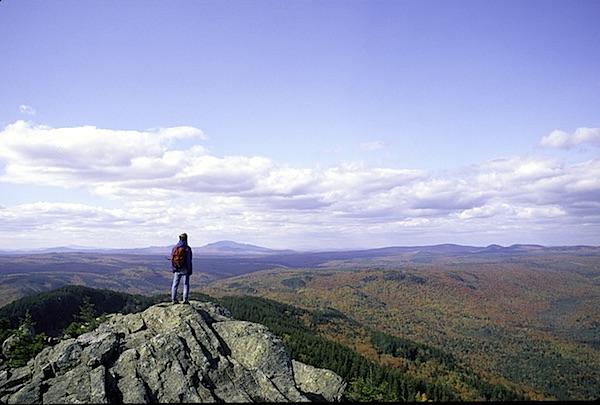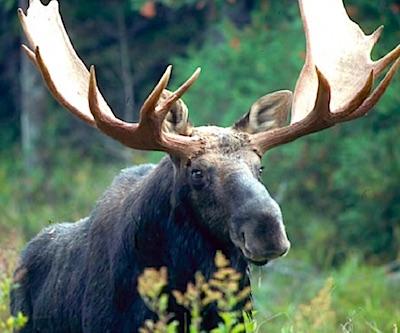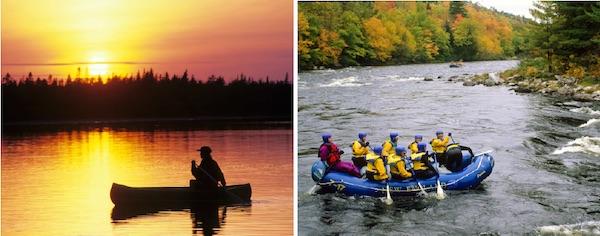
A hiker atop Borestone Mountain gazes into a potential national park in Maine/George Wuerthner
Maine isn't all rocky coastlines. Travel to the Pine Tree State's interior and you'll find a mythical, verdant, forested woodland of hemlock and balsam that inspired Henry David Thoreau's treatise, The Maine Woods.
"Every creature is better alive than dead, men and moose and pine trees, and he who understands it aright will rather preserve its life than destroy it," wrote Thoreau in expressing his concern for the future. "The mission of men there seems to be, like so many busy demons, to drive the forest out of the country.'
Under vast stands of ancient trees there are many shades of green, giant mushrooms, and mattress-soft patches of moss. The forest is so dense in places that just small shafts of sunshine penetrate and illuminate the ground, almost like spotlights. Occasionally, a moose will amble in and out of the timber, its domain embracing countless hidden lakes and streams that dot the woodlands.
The forest seems timeless.
But these woodlands have also been where families found their livelihoods for generations. They affectionately call it their 'wood basket,' where outdoorsmen, loggers, anglers, and hunters work and play. But now the woods are in conflict. Traditional users and preservationists debate the merits of a proposed national park and recreation area. The original national park proposal of the 1990s was huge; more than 3 million acres, nearly a third of Maine's Great North Woods. It envisioned one of the country's largest national parks, larger by almost a third than Yellowstone National Park. This plan was not well-received. Opponents were especially critical of millionairess Roxanne Quimby, who was donating 150,000 acres of her own lands towards a park.
Quimby is co-founder of Burt's Bees, whose honey-based lip balm and other personal care products made her a millionaire many times over. After selling the company, she has applied her wealth to conserve Maine landscapes.
But now a smaller plan is seeing more support from the locals. The current Katahdin Woods and Waters National Park and National Recreation Area proposal is just 5 percent as large as the first plan, would offer a blend of allowed activities and, according to proponents, involve less than 1 percent of the state's timber resources.
Just two hours from coastal Acadia National Park, the proposed park abuts Baxter State Park and has spectacular views of Mount Katahdin, the northern terminus of the Appalachian National Scenic Trail.
Quimby is prepared to donate 75,000 acres along the East Branch of the Penobscot River for the park, and another 75,000 acres for a national recreation area along its west bank. The national recreation area might help sooth local opinion as it could be open to hunting, fishing, and snowmobiling.
Quimby's son, Lucas St. Clair, has become its primary advocate. St. Clair is the president of Elliotsville Plantation Inc. (EPI), a company created to manage the land. (The entity's name comes from the unorganized township where Ms. Quimby first purchased lands with an eye on conservation.)

Maine's North Woods is a sanctuary for wildlife and wild lands dotted by lakes and threaded by rivers/George Wuerthner
St. Clair's grassroots approach has brought the boil back down to a simmer. He spends much of his time hunting and fishing in these very woods and discussing the proposal with proponents and opponents alike.
'We've been able to hear voices from people that are greatly affected by the outcome of this and we've been able to shape the proposal to meet the cultural and historical heritage of the region so that it really enhances what is here already as opposed to creating something that has never existed in the past,' he says.
Some opponents say the National Park Service can't manage what it already owns, and they are also wary of the federal government. During a park informational meeting in March, locals questioned the park's economics. Lincolnville resident and Friends of the Maine Woods member Andrew Young was quoted in the Bangor Daily News, as saying, 'The economic numbers do not make sense. This park will not happen. There is no money to make it happen.'
Against that view, however, St. Clair and his mother have pledged to raise a $40 million endowment for the proposed park; half would come from Ms. Quimby, and the other half from a matching campaign.
At the same time, hundreds of business owners have voiced support, saying a national park would be good for the economy as it would bolster the tourism sector and showcase a part of Maine that has been overshadowed by the state's coastal amenities and attractions.
While national park status is the nation's highest level of protection, the designation can carry some baggage. National parks may bring in tourism dollars, create jobs, and set high conservation standards, but they can also impose stricter environmental standards on surrounding industries, set restrictions on heavy recreational usage, and lure low-paying jobs.
And yet there's recognition that logging is no longer the economic stalwart it once was.
David Farmer, an EPI spokesman, concentrates upon the positive.
'It's not an either/or,' he says. 'We do not see this as competition. Industry and the national park can co-exist.'
Proponents, noting that Acadia is one of the country's top-ten visited parks, believe that a park in Maine's interior would further burnish the state's status as a tourism destination.
'An inland park would really complement the highly-toured coastline park,' says Farmer. 'This would allow tourists to move inland after a visit to Acadia for a more holistic look at the cultural, educational, and recreational experiences centered on Maine's woodland heritage.'
As mills close and young people move away in search of jobs, there's a growing sense that something needs to change for the state's economy.

From peaceful backcountry paddling destinations to thrilling whitewater adventures, Maine's North Woods offers an array of recreational opportunities/George Wuerthner
Gail Sanjoy, president of the Katahdin Chamber of Commerce, says, 'The proponents of the national park don't believe that the national park standing alone will be our area's savior, but it will go a long way from where we are today. We need to explore all options, and keep all options on the table, and the national park happens to be the offer on the table right now.'
In March the Bangor City Council voted 7-2 to support the concept of a national park, joining the towns of Millinocket, East Millinock, and the Penobscot Indian Nation. In late March, more than 200 Maine business owners sent a letter of support to their congressional delegation, which has not as yet supported the concept, choosing to listen to their constituents. But it's obvious that support is growing.
Proponents see the land and its endowment as an incredible gift at a time when economic options are limited, and feel something needs to be done. For others, these woods are their home, which contribute much more than hiking trails for the occasional tourist.
Miri Gubler spent the spring semester as an editorial intern with the Traveler. She previously has written about Acadia National Park and California condors



Comments
No - when you ask for and take on obligations beyond your budget - its your fault.
Another strawman. There is no reason the land trust would have to "shut off public access". The access could be equal or even greater than it is now.
But, certain land trusts do have a tendancy to shut off access to land. It's quite common actually. I support what the Nature Conservancy does at times, but many times they don't open the lands in their trust to the public, or it's very limited access. At least with a National Park this usually isn't the case. Maybe there will be closures here and there to protect species, or certain resources, or maybe they limit access via permits, but rarely are areas shut off to the public outright.
I would like to think, Eric, that if the people decide a landscape should be included in the National Park System, Congress should acknowledge that and see that the Park Service has the funds to provide for that new site.
Of course, I also believe that if Congress decides on its own to add to the National Park System it should provide the money to the Park Service to administer that site, and I don't see that always happening.
And really, when you consider that the NPS budget is either 1/13 or 1/15 of 1 percent of the federal budget, I think the money exists to provide for these places.
The discussion here points to a deeper problem--the vanishing American worker. I sympathize that tourism may save northern Maine; then again, what if the new park only dilutes the market and the Park Service budget besides? Is tourism what we need to "save" America, or an economy that makes sense for everyone? The Maine woods? Why can't Maine save them, just as New York saved the Adirondacks? Do the Adirondacks lack for tourists? No. However, they will soon lack for them if upstate New York fails at rebuildng its rust-belt economy.
In this case, why let Congress off the hook? You have another trade bill before you promising us the Moon if we trade off American jobs to the "Pacific." Which is it? Do we get to keep our country or just keep making parks no one intends to fund?
Environmental Studies 101 starts with the admission that full employment is the prerequite for parks. Not hamburger flippers, either. After denuding these northern forests once, we realize that denuding them a second time bears enormous costs. In New York State, that led to state ownership of 2.5 million acres of the Adirondacks, and strict controls over 2.5 million more. The people who went there worked for Kodak, Xerox, IBM, Endicott-Johnson, Corning, Kroehler, Universal Instruments, Link Aviation, Ansco, Pittsburgh Steel, and many more. In 1960, New York still had 45 electoral votes. Buffalo's economy was the 10th largest IN THE WORLD.
Okay, I digress. We were talking about parks. But that is how you get them--a robust middle class. You don't get them--and certainly will not keep them--by selling tourism to local economies that are shot. Everywhere I travel, people are feeling pinched. They may still be spending, but they feel insecure. That is the problem we need to resolve before asking Congress for more national parks.
That isn't how our Constitution works. And you should be thankful for that.
Fully agree, put exactly what parks were established over NPS objections?
From Alfred:
Agreed, but I fear you and I would have different proposals on how to solve the problem.
Thank you Kurt and Dr Runte. Actually a great blueprint for new parks after the railroad era of Directors Mather and Allbright was DOI Secretary Harold Ickes and his plan for Cedar Grove in Kings Canyon National Park. Except for campgrounds, concession facilities were extremely modest, nothing has changed. When you get to Cedar Grove it really strikes you as a National Park, campgrounds and trailheads, that is about it. No Ahwahnee Hotel, Yosemite Lodge, massive gift shops, super market, etc. An excellent book on this issue is "Righteous Pilgrim, The Life and Times of Harold L. Ickes, 1874-1952" by T.H. Watkins. In any case, thank you again Alfred, you are right on, as usual, in my view.
Unfortunately, Dr. Runte is exactly correct.
The REAL foundation of America has always been its workers. They are the people who BUILT this country with their sweat and, sometimes, blood. Our farmers, miners, construction workers, teachers, bank tellers, housewives, sewer plant operators, firefighters, police, nurses, nurses aides and countless other hard working Americans. Without them, and their efforts, those at the top would be helpless and impoverished, for indeed they did not build it themselves.
Once upon a time, our national parks were playgrounds for the elite. Now they are, and must continue to be, places of respite for those whose hard work makes it possible for the elite to be elite.
Lee, I don't dismiss the contribution of the "workers" but they "did not build it themselves" either. Its a symbiotic relationship. We wouldn't have the great nation we have without both.